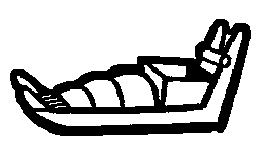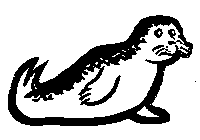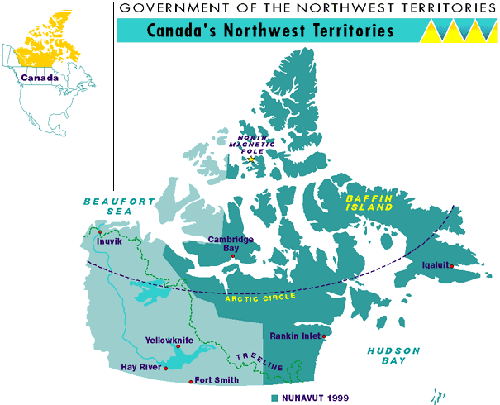 |
|
|
The Inuit - Hunters of the Arctic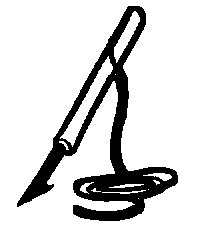
Summary: Text: Günter Cornett - Graphics: Christof Tisch |
|
Here, we also find the polar bear. Nanuk, the Great Wanderer, the Inuit call it. In search of food, the bear often travels hundreds of miles. It has an excellent sense of orientation and can weigh as much as 300 kg. With his paws it can kill even the Beluga Whale and drag it onto the ice. 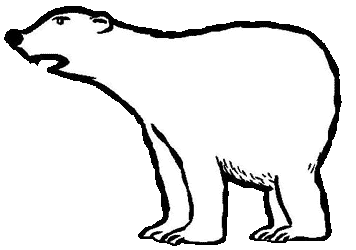 The polar bear has developed variable techniques for hunting the seal, his main source of food. According to some accounts, the bear even covers his telltale black nose with a paw while creeping near. The Inuit mainly hunted the polar bear for its hide. The meat is not very palatable and is only eaten in times of dire need. It was arduous to follow the bear through the pack ice by dog sledge, and it was quite dangerous to stand up to it armed only with a harpoon.
Today, the bears come near the settlements on their own account, lured by the rubbish bins. They are hard to chase away and would be easy prey to the rifles of the Inuit.
Seals, whales and walruses provided the Inuit with meat that was usually eaten raw due to lack of fuel. In addition, they were the source of fat and tallow for the lamps, hides for clothing and kayaks, bones for tools and weapons and sinews for strings.
The Inuit hunts seals all through the year. When the seals dive beneath the ice they will surface again in special ice holes to breathe. Because seals use more than one breathing hole and are rather suspicious, a hunter may have to wait motionless beside the hole for many hours until he can strike with his harpoon.
In contrast, hunting the walrus was dangerous for the hunter as well as tedious, at least before rifles were used. Traditional tales of the Inuit have it that hunters have been pulled under the ice by walruses, which can weigh hundreds of kilograms. The saber-like canine teeth are up to one metre long, and the walrus can use them to punch breathing holes through an ice sheet two feet thick.
Similarly, the hunt for the large species of whales was not without danger; we are talking about animals here that may be 20 metres long. In former times, they were hunted with harpoons from larger boats. Today, following the near extinction of the Greenland whale by British, Dutch and American whalers in the 19th century, whale hunting is forbidden with only a few exceptions for necessary self-support of the Inuit.
The Beluga is also called the "canary of the sea" because of its "songs". The echo of the sounds the whales emit not only enables them to communicate over vast distances but also to orient themselves under water and to locate, for example, shoals of fish. Accordingly, whales are not only endangered by industrial whaling methods but also by the "noise pollution" caused by hundreds of ships that roam those waters every year. More about the White Whale: http://www.mmsc.org/info/whale-beluga.html, http://www.zetnet.co.uk/sigs/cetacean/cetlist.html |
Whalers, Fur Traders, Missionaries, ...The life of the Inuit changed again with the arrival of whalers, fur traders and missionaries. Soon the Inuit did not only hunt for their living but also to barter for rifles, sugar, tobacco and alcohol. Thus, they fell into a dependency on trade. Because, with rifles, ever more animals were killed, the natural balance of the Arctic began to stagger. The Inuit had to roam ever-increasing distances to hunt their prey. Also, Christianity forced its monotheistic philosophy upon the Inuit, along with foreign laws and morals. Polygamy and swapping partners were banned and new laws were introduced. Originally, the shaman or "angakok" decided what to do in case somebody broke the rules of the community. The idea was not mainly to punish the culprit, but rather to re-establish the balance that was felt to be natural. To this purpose there were a number of rites, magic ceremonies and taboos. The angakok also healed ailments and advised in matters of foraging. Today, most Inuit have converted to Christianity.
Military Forces + Multi-National Groups = Development ?The most serious changes in the lives of the Inuit came only in this century, when the north became interesting for governments and companies for its military importance and its resources. "During the Second World War and the years after that, relations between the Inuit and Canadians developed very fast. Airfields, weather stations and radar installations were built in the north of Canada. Later, national services and tapping and mining of resources followed. The discovery of oil and gas deposits brought thousands of people from the cities in southern Canada to the north. At that time the Canadian administration decided that it would be necessary to provide medical and social services and schools to the Inuit. The administration increased its presence in the north substantially. The effect was that the Inuit by and by aggregated into many larger but fewer settlements that were built to last and that provided schools, churches, administration offices and shops." This is the official statement of the Canadian Government, translated from a text found on the home page of the Canadian Embassy in Germany, http://www.dfait-maeci.gc.ca/~bonn/Canada/FirstNations/g_dinuit.htm (german text). However, the Gesellschaft für bedrohte Völker judges differently about this period of history: "In the wake of the whalers and fur traders, multi-national companies fell upon the region in their search for oil, natural gas, uranium, lead and zinc and caused an uprooting of traditional culture. Moreover, the Canadian policy of forced assimilation drove many Inuit into dependency from welfare aid and caused loss of identity and often led to escape into alcoholism. High suicide rates show that the imposed way of living has become a torture. In the camps of the oil companies abuse of alcohol, theft and violation have reached an above-average and frightening level." |
Environmental DangersThe Arctic environment is not only endangered by the well-known hole in the ozone layer but also by a multitude of poisons like DDT, furane and postchlorinated biphylene. They are generated in industrial regions and transported into the Arctic by atmospheric currents. The polar air and water are no longer pure. High levels of harmful substances have been found not only in fish and polar mammals but also in the milk of Inuit women. Another threat is posed by the radioactive waste that has been dumped into the Arctic Sea by the Soviet Union since 1959, and even more so by the British reprocessing plant at Sellafield, UK. Only recently the traces of radioactive discharges of that plant have been detected in the Polar Sea. The consequences of excessive fishing for the balance of nature have recently been published in the "Frankfurter Rundschau" (a German newspaper), based on an article in "Science":
Protection of Animals, and the ConsequencesParadoxically, the Inuit have not only been victims to the exploitation of their "lebensraum", but they also suffered from measures directed at the preservation of the Arctic fauna: "The Inuit have been hard-hit when the European Union banned the import of seal hides in 1983. Environmentalist organizations like Greenpeace, the World Wildlife Fund and other associations for the protection of animals had been protesting, for perfectly valid reasons, against the slaughter of baby seals by Canadian and Norwegian hunters, and demanded protective action. The seal hide market crashed. The Inuit, who in order to preserve the stock had never hunted baby seals, could suddenly no longer earn their living by hunting the grown-up animals. They also had to refrain from whaling. An important part of their cultural integrity and their social system vanished without any replacement. A similar threat looms in the import ban on hides of wild animals, as proposed by the European Union. This would concern the Inuit and the other native population of Canada. In 1995, about 35.000 of them had a license to hunt with traps. Usually they have no other income, especially those living in the remote northern settlements. Inuit organizations protested, not least, against the way in which this ban was to be imposed: in bad, colonial manner, without talking to those concerned."(Theodor Rathgeber on the home page of the "Gesellschaft für bedrohte Völker" Gesellschaft für bedrohte Völker, http://www.gfbv.de/voelker/nordam/inuit.htm german text). At the time, Greenpeace argued that their protest was not directed against the Inuit, "but when they supplied to an international market they could no longer call this 'traditional seal hunting'. Anybody who enters international trade and uses its mechanics must necessarily also bear the risk of the ever-changing market situation, which may be caused by the currents of fashion or an increased environmental consciousness in the buyer countries. In truth, the Inuit are the victims of the irresponsible actions of the seal fur industry." (Greenpeace, Seals, Claims and Background Information, March 1996). But today the Inuit could no longer sustain themselves by hunting alone. Actually, they still live mainly on the meat of wild animals. But because they live, by now, in heated buildings, they have high expenses for heating and for importing of goods. 60 to 70% of northern Canada's population are unemployed and have to rely on welfare. |
A New BeginningIn an attempt to stay as near as possible to their traditional way of life, the Inuit of Canada, Alaska, Greenland and Russia, as early as the 1970s, founded the Inuit Circumpolar Conference (ICC) as an international group to represent their interests. The ICC takes up problems like pollution, the extinction of marine mammals, excessive exploitation of resources as well as problems of alcoholism in the Inuit population. One important question is that of land ownership. The official Canadian legislation holds that any land that is not private property is the property of Canada. This position is opposed to the natural rights of the original inhabitants who have been living there and using the land for centuries. The Inuit put great hopes into the foundation of a new Canadian federal state named 'Nunavut' (="our land"). Since April 1st, 1999 the Northwest Territories have been divided along the tree line in two provinces:
The eastern part, Nunavut, has a population of just 25.000 in an area of about 2 million square kilometers. The Inuit got deeds of property for 350.000 square kilometers of land, financial compensation, hunting and fishing rights and more legal rights of participation in decisions about the way the region and its environment are run and used. Furthermore, there are plans to limit Canadian jurisdiction to cases of capital offence to make possible the re-installation of traditional ways to handle conflicts. Another proposed innovation, to guarantee a quota of 50% female members of parliament, has recently only just fallen through in a plebiscite. But critical voices are also present, particularly of white inhabitants that still control the administration, educational institutions and health service, and of the Indians. "Some people say that the Inuit have grabbed too big a piece of the cake. The area of land remaining for the other original inhabitants of the region, the Indians, is only a very small piece of land in the western part of the Northwest Territories." (Illustrierte Wissenschaft, Sept. 1998). But 85% of the population of Nunavut are Inuit, and another 10% are white. John Amagoalik, chairman of the Nunavut Implementation Commission that is responsible building up the province, even believes that Nunavut "will be pointing the way for all the conflicts with natives and minorities in the world". Bushmen from Botswana and Australian aborigines already have paid informational visits to the capital of Nunavut, Iqaluit, a town of 4500 souls.
For all who do not want to travel that far, the Internet is a very good source of information. Once you have found the right web pages you will gather a lot of interesting facts there about the Arctic and its fauna, about Nunavut, and about the history and the myths of the Inuit. Thankfully, Jane T. of Iqaluit has helped me a lot with the research. Jane told me about today's way of living in the Arctic regions (see inset), looked up a lot of interesting Internet links, and commented upon them. All this greatly eased my search for information..
Günter Cornett |
 |
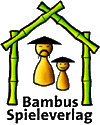 |
   
Bambus Spieleverlag Günter Cornett | Kopfstraße 43 | D-12053 Berlin Phone/Fax: +49-30-6121884 |
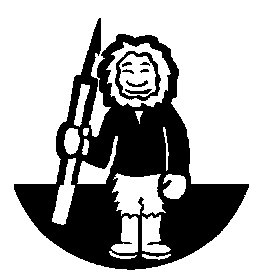
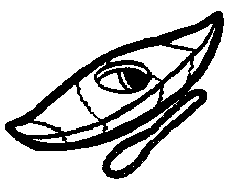 The main hunting ground was the pack ice. Currents and wind separate the ice floes, which may be three to seven feet thick, or pile them on top of each other. Where the cracks form, we find the migration straits of the polar whales, which must surface to breathe. Seals and walruses need the ice floes to rest as well as the water to hunt and feed.
The main hunting ground was the pack ice. Currents and wind separate the ice floes, which may be three to seven feet thick, or pile them on top of each other. Where the cracks form, we find the migration straits of the polar whales, which must surface to breathe. Seals and walruses need the ice floes to rest as well as the water to hunt and feed.

